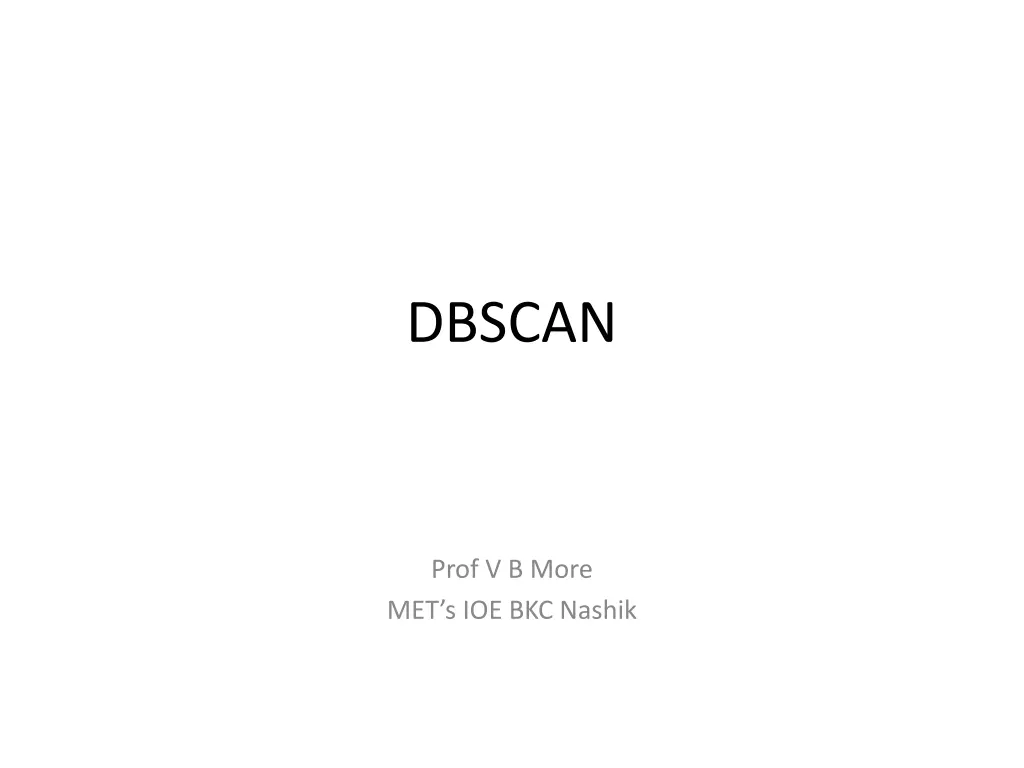
Understanding DBSCAN Algorithm for Density-Based Clustering
"Learn about the DBSCAN algorithm, its applications, and working principles in detail. Explore traditional density-based approaches for clustering and how DBSCAN is a simple yet effective solution. Find out more with Prof. V.B. More at MET BKC IOE Nashik."
Download Presentation

Please find below an Image/Link to download the presentation.
The content on the website is provided AS IS for your information and personal use only. It may not be sold, licensed, or shared on other websites without obtaining consent from the author. If you encounter any issues during the download, it is possible that the publisher has removed the file from their server.
You are allowed to download the files provided on this website for personal or commercial use, subject to the condition that they are used lawfully. All files are the property of their respective owners.
The content on the website is provided AS IS for your information and personal use only. It may not be sold, licensed, or shared on other websites without obtaining consent from the author.
E N D
Presentation Transcript
DBSCAN Prof V B More MET s IOE BKC Nashik
DBSCAN DBSCAN Unit 5 Decision Trees and Ensemble Learning Decision Trees- Impurity Importance. Decision Tree Classification with Scikit- learn, Ensemble Learning-Random AdaBoost, Gradient Tree Boosting, Voting Classifier. Clustering Fundamentals- Basics, K-means: Finding optimal number of clusters, DBSCAN, Spectral Clustering. Evaluation methods based on Ground Truth- Homogeneity, Completeness, Adjusted Rand Index. Introduction to Meta Classifier: Concepts of Weak and eager learner, Ensemble methods, Bagging, Boosting, Random Forests. measures, Feature Forest, Prof V B More, MET BKC IOE Nashik 2
DBSCAN DBSCAN DBSCAN DBSCAN Q. What is DBSCAN? When we need to use it? Explain Working of DBSCAN in detail. => Density-based clustering locates regions of high density that are separated from one another by regions of low density. Prof V B More, MET BKC IOE Nashik 3
DBSCAN DBSCAN DBSCAN DBSCAN is a simple and effective density- based clustering algorithm helpful for any density-based clustering approach. Prof V B More, MET BKC IOE Nashik 4
DBSCAN DBSCAN DBSCAN Traditional Density: Center-Based Approach In the center-based approach, density is estimated for a particular point in the data set by counting the number of points within a specified radius, Eps, of that point. This includes the point itself. Prof V B More, MET BKC IOE Nashik 5
DBSCAN DBSCAN DBSCAN Traditional Density: Center-Based Approach The number of points within a radius of Eps of point A is 7, including A itself. Prof V B More, MET BKC IOE Nashik 6
DBSCAN DBSCAN DBSCAN Traditional Density: Center-Based Approach This method is simple to implement, but the density of any point will depend on the specified radius. For e.g., if the radius is large enough, then all points will have a density of m, the number of points in the data set. Prof V B More, MET BKC IOE Nashik 7
DBSCAN DBSCAN DBSCAN Traditional Density: Center-Based Approach Likewise, if the radius is too small, then all points will have a density of 1. Prof V B More, MET BKC IOE Nashik 8
DBSCAN DBSCAN DBSCAN Classification of Points According to Center- Based Density Classify a point as being (1) in the interior of a dense region (a core point), (2) on the edge of a dense region (a border point), or (3) in a sparsely occupied region (a noise or background point). Prof V B More, MET BKC IOE Nashik 9
DBSCAN DBSCAN DBSCAN Classification of Points According to Center- Based Density Graphical Illustration of core, border, and noise points using a collection of two-dimensional points. Prof V B More, MET BKC IOE Nashik 10
DBSCAN DBSCAN DBSCAN Classification of Points According to Center- Based Density Core points: These points are in the interior of a density-based cluster. A point is a core point if the number of points within a given neighborhood around determined by Eps, exceeds a certain threshold, MinPts, which is also a user- specified parameter. Point A is a core point, for the indicated radius (Eps) if MinPts <= 7. the point as Prof V B More, MET BKC IOE Nashik 11
DBSCAN DBSCAN DBSCAN Classification of Points According to Center- Based Density Border points: A border point is not a core point, but falls within the neighborhood of a core point. Point B is a border point. A border point can neighborhoods of several core points. fall within the Prof V B More, MET BKC IOE Nashik 12
DBSCAN DBSCAN DBSCAN Classification of Points According to Center- Based Density Noise points: A noise point is any point that is neither a core point nor a border point. Point C is a noise point. Prof V B More, MET BKC IOE Nashik 13
DBSCAN DBSCAN DBSCAN algorithm. 1: Label all points as core, border, or noise points. 2: Eliminate noise points, 3: Put an edge between all core points that are within Eps of each other. 4: Make each group of connected core points into a separate cluster. 5: Assign each border point to one of the clusters of its associated core points. Any two core points that are close enough-within a distance Eps of one another are put in the same cluster. Prof V B More, MET BKC IOE Nashik DBSCAN 14
DBSCAN DBSCAN DBSCAN Clusters found using DBSCAN Sample Data Distance plot of Sample Data Prof V B More, MET BKC IOE Nashik 15
DBSCAN DBSCAN DBSCAN Clusters found using DBSCAN DBSCAN Clustering of 3000 two-dimensional points Clusters found by DBSCAN Prof V B More, MET BKC IOE Nashik 16
DBSCAN DBSCAN DBSCAN Clusters found using DBSCAN Prof V B More, MET BKC IOE Nashik 17
